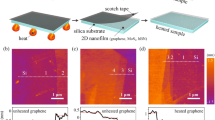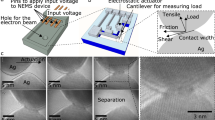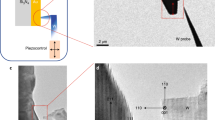Abstract
The physics of sliding nanofriction at high temperature near the substrate melting point, TM, is so far unexplored. We conducted simulations of hard tips sliding on a prototype non-melting surface, NaCl(100), revealing two distinct and opposite phenomena for ploughing and for grazing friction in this regime. We found a frictional drop close to TM for deep ploughing and wear, but on the contrary a frictional rise for grazing, wearless sliding. For both phenomena, we obtain a fresh microscopic understanding, relating the former to ‘skating’ through a local liquid cloud, and the latter to linear response properties of the free substrate surface. We argue that both phenomena occur more generally on surfaces other than NaCl and should be pursued experimentally. Most metals, in particular those possessing one or more close-packed non-melting surfaces, such as Pb, Al or Au(111), are likely to behave similarly.
This is a preview of subscription content, access via your institution
Access options
Subscribe to this journal
Receive 12 print issues and online access
$259.00 per year
only $21.58 per issue
Buy this article
- Purchase on Springer Link
- Instant access to full article PDF
Prices may be subject to local taxes which are calculated during checkout





 as a function of temperature for surface atoms alone.
as a function of temperature for surface atoms alone.
Similar content being viewed by others
References
Dowson, D., Taylor, C., Godet, M. & Berthe, D. Development in Numerical and Experimental Methods Applied to Tribology (Butterworths, London, 1984).
Bowden, F. P. & Tabor, D. Friction: An Introduction to Tribology (Doubleday, New York, 1973).
Krylov, S. Y., Jinesh, K. B., Valk, H., Dienwiebel, M. & Frenken, J. W. M. Thermally induced suppression of friction at the atomic scale. Phys. Rev. E 71, 065101 (2005).
Hammerberg, J. E., Holian, B. L., Germann, T. C. & Ravelo, R. Nonequilibrium molecular dynamics simulations of metallic friction at Ta/Al and Cu/Ag interfaces. Metall. Mater. Trans. A 35, 2741–2745 (2004).
Zhang, L. C. & Cheong, W. C. D. in High Pressure Surface Science and Engineering (eds Gogotsi, Y. & Domnich, V.) Ch. 2.2 (Institute of Physics, Bristol, 2004).
Tartaglino, U., Zykova-Timan, T., Ercolessi, F. & Tosatti, E. Melting and nonmelting of solid surfaces and nanosystems. Phys. Rep. 411, 291–321 (2005).
Kuipers, L. & Frenken, J. Jump to contact, neck formation, and surface melting in the scanning tunneling. Phys. Rev. Lett. 70, 3907–3910 (1993).
Tomagnini, O., Ercolessi, F. & Tosatti, E. Microscopic interaction between a gold tip and a Pb(110) surface. Surf. Sci. 287/288, 1041–1045 (1993).
Zykova-Timan, T., Tartaglino, U., Ceresoli, D. & Tosatti, E. Why are alkali halide surfaces not wetted by their own melt? Phys. Rev. Lett. 94, 176105 (2005).
Gnecco, E., Bennewitz, R. & Meyer, E. Abrasive wear on the atomic scale. Phys. Rev. Lett. 88, 215501 (2002).
Fumi, F. G. & Tosi, M. P. Ionic sizes and born repulsive parameters in the NaCl-type alkali halides. J. Phys. Chem. Solids 25, 45–52 (1964).
Zykova-Timan, T., Ceresoli, D., Tartaglino, U. & Tosatti, E. Physics of solid and liquid alkali halide surfaces near the melting point. J. Chem. Phys. 123, 164701 (2005).
Anwar, J., Frenkel, D. & Noro, M. G. Calculation of the melting point of NaCl by molecular simulation. J. Chem. Phys. 118, 728–735 (2003).
Grange, G. & Mutaftschiev, B. Méthode de mesure de l’angle de contact à l’interface cristal-bain fondu. Surf. Sci. 47, 723–728 (1975).
Persson, B. J. Sliding Friction: Physical Principles and Applications (Springer, Berlin, 1998).
Levitas, V. I., Henson, B. F., Smilowitz, L. B. & Asay, B. W. Solid-solid phase transformation via internal stress-induced virtual melting, significantly below the melting temperature. Application to HMX energetic crystal. J. Phys. Chem. B 110, 10105–10119 (2006).
Tartaglino, U. & Tosatti, E. Strain effects at solid surfaces near the melting point. Surf. Sci. 532–535, 623–627 (2003).
Dienwiebel, M. et al. Superlubricity of graphite. Phys. Rev. Lett. 92, 126101 (2004).
Hansen, J. P. & McDonald, I. R. Theory of Simple Liquids Ch. 8 (Academic, London, 1986).
Granato, E., Ala-Nissila, T. & Ying, S. Anomalous sliding friction and peak effect near the flux lattice melting transition. Phys. Rev. B 62, 11834–11837 (2000).
Ala-Nissila, T. & Ying, S. Microscopic theory of surface diffusion. Phys. Rev. B 42, 10264–10274 (1990).
Tang, C., Ling, X., Bhattacharya, S. & Chaikin, P. Peak effect in superconductors: Melting of Larkin domains. Europhys. Lett. 35, 597–602 (1996).
Acknowledgements
This work was sponsored by MIUR FIRB RBAU017S8 R004, FIRB RBAU01LX5H, and MIUR COFIN 2003 and 2004, as well as by INFM (Iniziativa trasversale calcolo parallelo). We acknowledge illuminating discussions with, and much help from, U. Tartaglino.
Author information
Authors and Affiliations
Corresponding author
Ethics declarations
Competing interests
The authors declare no competing financial interests.
Supplementary information
Supplementary Information
Supplementary movie 1 (AVI 2836 kb)
Supplementary Information
Supplementary movie 2 (AVI 2660 kb)
Supplementary Information
Supplementary movie 3 (AVI 2709 kb)
Rights and permissions
About this article
Cite this article
Zykova-Timan, T., Ceresoli, D. & Tosatti, E. Peak effect versus skating in high-temperature nanofriction. Nature Mater 6, 230–234 (2007). https://doi.org/10.1038/nmat1836
Received:
Accepted:
Published:
Issue Date:
DOI: https://doi.org/10.1038/nmat1836
This article is cited by
-
Observed edge radius behavior during MD nanomachining of silicon at a high uncut chip thickness
The International Journal of Advanced Manufacturing Technology (2019)
-
Friction laws at the nanoscale
Nature (2009)
-
Skating on hot surfaces
Nature Materials (2007)
-
Scratching the surface
Nature Nanotechnology (2007)
-
Friction at the nanoscale, nanofluidic diodes, rewriting with dip-pen nanolithography and more
Nature Nanotechnology (2007)



